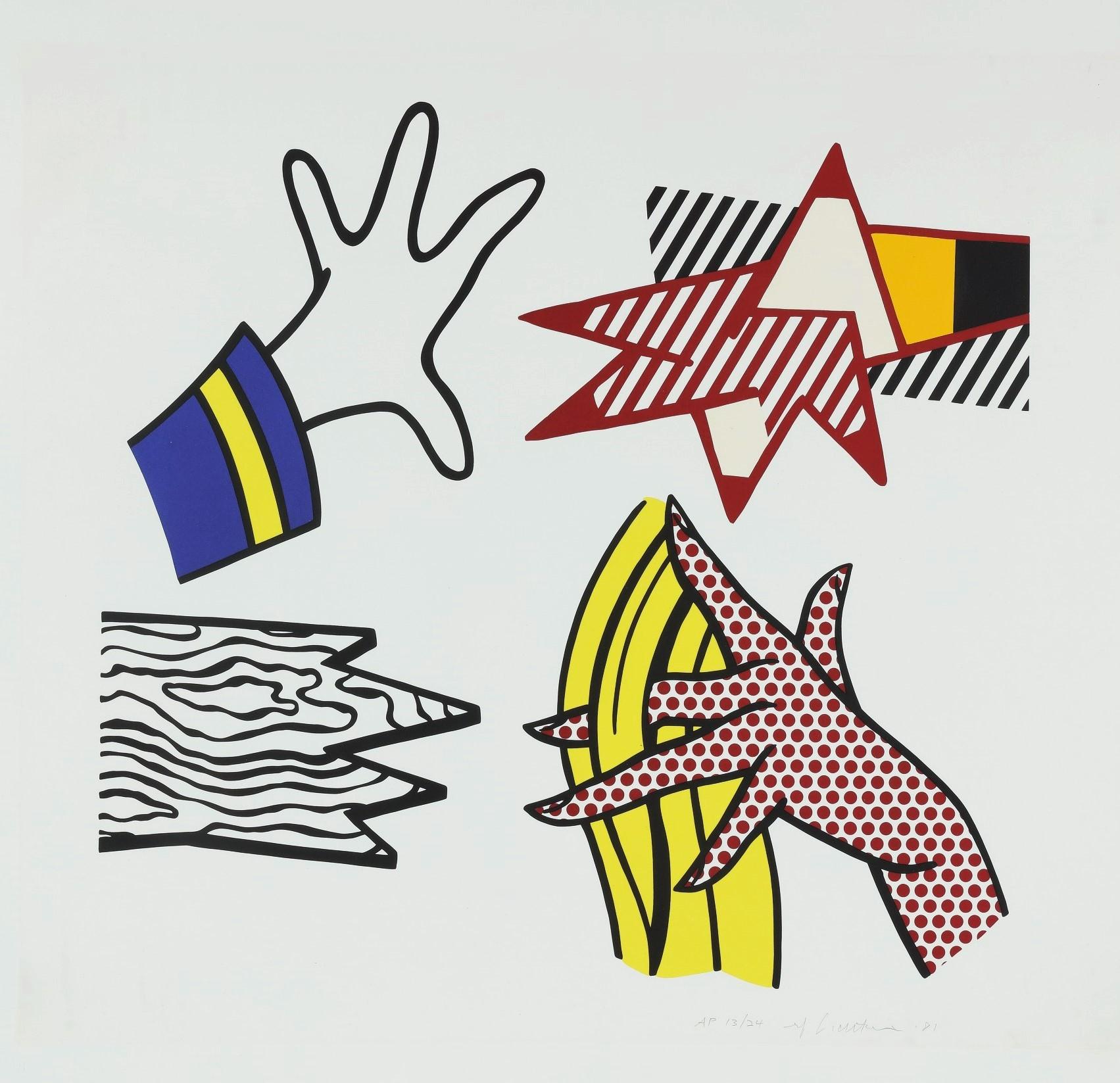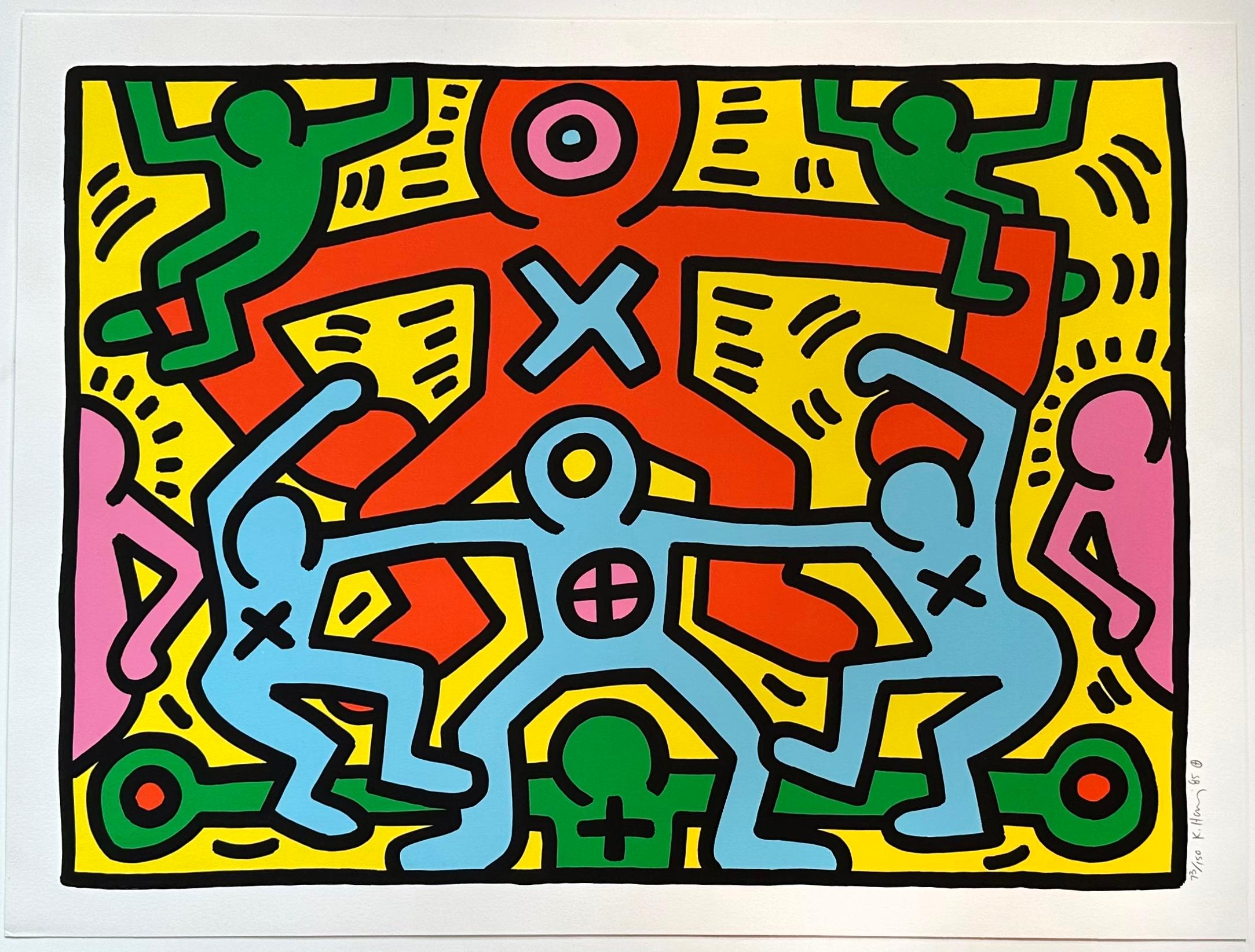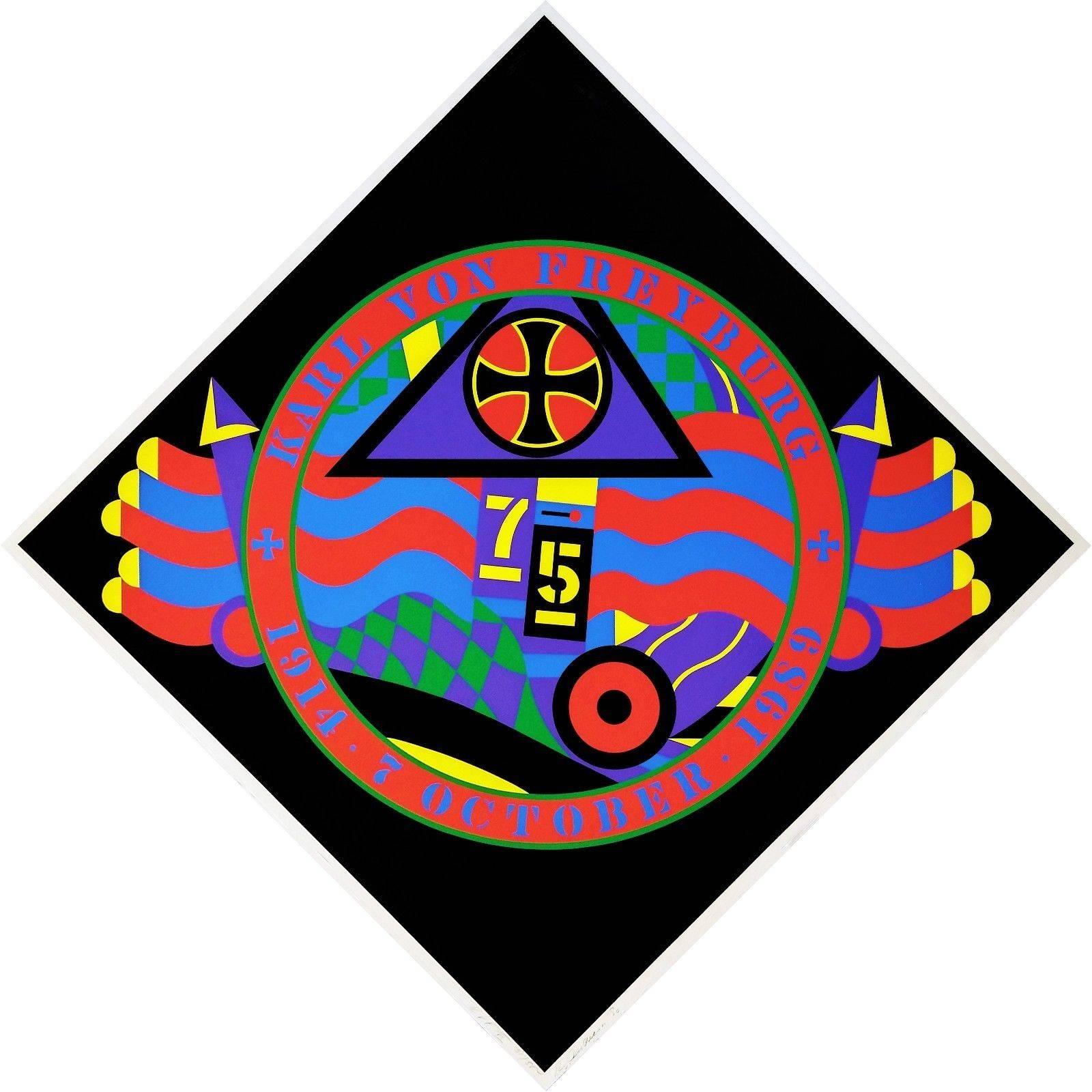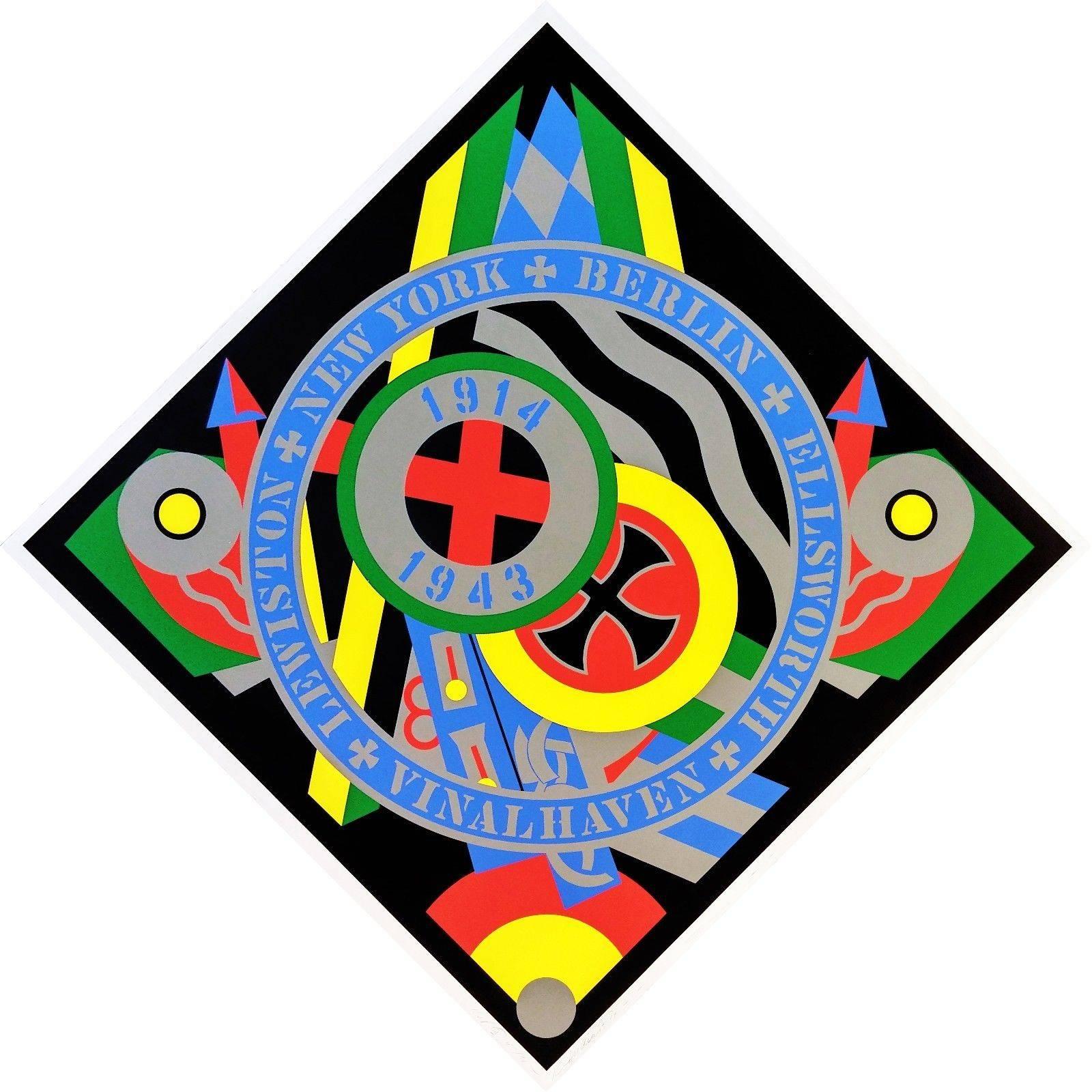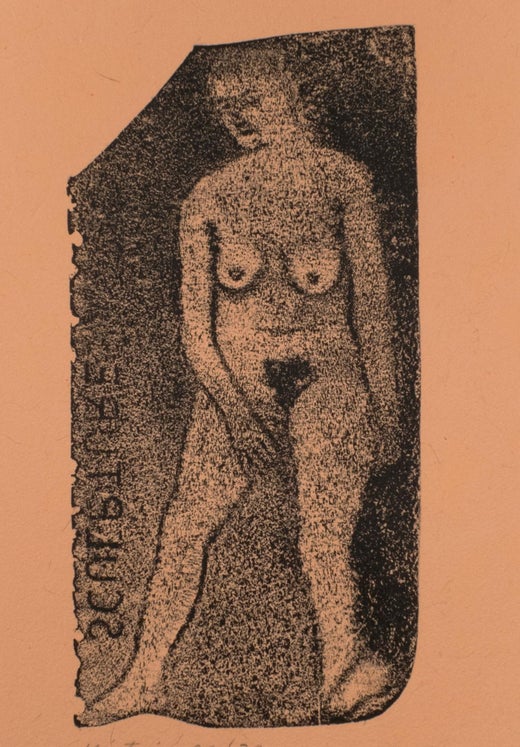Want more images or videos?
Request additional images or videos from the seller
1 of 7
Ronald Brooks KitajBAGHDAD1972
1972
About the Item
Ronald Brooks (R.B.) Kitaj
BAGHDAD, 1972
Six Color Screenprint and Photoscreenprint
20 × 14 1/2 inches
Pencil signed and numbered 1/125
Printed at Kelpra Studio, London
Published by Marlborough Graphics, N.Y.
Unframed
Catalogues:
Kelpra Nº 7977
Kinsman Nº 53
British Museum Nº162 (reproduced on page 158)
Kitaj's "Baghdad" is one of the prints from the portfolio Prints for Phoenix House. A portfolio of ten prints by various artists, including Kitaj, Ellsworth Kelly, Alex Katz, David Hockney, Adolph Gottlieb, Joseph Cornell and James Rosenquist.
An excellent impression of this uncommon and desirable silkscreen from the early 1970s. Unframed and in fine condition. Terrific work by this very important British Pop art pioneer
More about R.B. (Ronald Brooks) Kitaj:
Born in Cleveland, Ohio, to a Viennese mother and Jewish stepfather, Ronald Brooks (R.B.) Kitaj became a noted painter and printmaker whose subjects were realistic and abstract figure and genre. Many of his works were inspired by his political ideas and by reactions to stories he heard from his family about the Nazis during World War II. At an early age, he developed a compassion for persons less fortunate and became dedicated to socialism, which had a lasting effect on his life and work. He was stirred by discussions about the Republican cause in the Spanish Civil War and by the events during World War II in Europe, especially as recollected by his parents and his Jewish step-grandmother, who moved in with his family. Kitaj also learned much on various voyages as a merchant seaman in Latin America and through attending art schools, first in 1950 at the Cooper Union for the Advancement of Science and Art in New York, and in 1951 to 1952 at the Akademie der Bildenden Knste, Vienna, under Albert Paris von Gtersloh. After his marriage in 1953 to Elsi Roessler, a fellow American student whom he had met in Vienna, he made his first extended visit to the Catalan port of San Felu de Guixols, and he continued to return their regularly over the next 30 years. From 1955 to the end of 1957 he served in the American Army near Fontainebleau, where he drew pictures of the Russian tanks and installations for war games. Kitaj was recognised as being one of the world's leading draftsmen, almost on a par with, or compared to, Degas. Indeed, he was taught drawing at Oxford by Percy Horton, himself a pupil of Walter Sickert, who was a pupil of Degas; and the teacher of Degas studied under Ingres. His more complex compositions build on his line work using a montage practice, which he called 'agitational usage'. Kitaj often depicts disorienting landscapes and impossible 3D constructions, with exaggerated and pliable human forms. He often assumes a detached outsider point of view, in conflict with dominant historical narratives. This is best portrayed by his masterpiece "The Autumn of Central Paris" (1972–73), wherein philosopher Walter Benjamin is portrayed, as both the orchestrator and victim of historical madness. The futility of historical progress creates a disjointed architecture that is maddening to deconstruct. He staged a major exhibition at Los Angeles County Museum of Art in 1965, and a retrospective at the Hirshhorn Museum in Washington D.C. in 1981. He selected paintings for an exhibition, "The Artist's Eye", at the National Gallery, London in 1980. In his later years, he developed a greater awareness of his Jewish heritage, which found expression in his works, with reference to the Holocaust and influences from Jewish writers such as Kafka and Walter Benjamin, and he came to consider himself to be a "wandering Jew". In 1989, Kitaj published "First Diasporist Manifesto", a short book in which he analysed his own alienation, and how this contributed to his art. His book contained the remark: "The Diasporist lives and paints in two or more societies at once." And he added: "You don't have to be a Jew to be a Diasporist." A second retrospective was staged at the Tate Gallery in 1994. Critical reviews in London were almost universally negative. British press savagely attacked the Tate exhibit, calling Kitaj a pretentious poseur who engaged in name dropping. Kitaj took the criticism very personally, declaring that “anti-intellectualism, anti-Americanism, and anti-Semitism” had fueled the vitriol. Despite the bad reviews, the exhibition moved to the Metropolitan Museum of Art in New York and afterwards to the Los Angeles County Museum in 1995. His second wife, Sandra Fisher died of a brain aneurysm in 1994, shortly after his exhibition at the Tate Gallery had ended. He blamed the British press for her death, stating that “they were aiming for me, but they got her instead.” David Hockney concurred and said that he too believed the London art critics had killed Sandra Fisher. Kitaj returned to the US in 1997 and settled in Los Angeles, near his first son. The "Tate War" and Sandra's death became a central themes for his later works: he often depicted himself and his deceased wife as angels. Kitaj was one of several artists to make a post-it note in celebration of 3M's 20th anniversary. When auctioned on the internet in 2000, the charcoal and pastel piece sold for $925, making it the most expensive post-it note in history, a fact recorded in the Guinness Book of World Records. Kitaj was elected to the Royal Academy in 1991, the first American to join the Academy since John Singer Sargent. He received the Golden Lion at the Venice Biennale in 1995. He staged another exhibition at the National Gallery in 2001, entitled "Kitaj in the Aura of Cézanne and Other Masters". In September 2010 Kitaj and five British artists including Howard Hodgkin, John Walker, Ian Stephenson, Patrick Caulfield and John Hoyland were included in an exhibition entitled The Independent Eye: Contemporary British Art From the Collection of Samuel and Gabrielle Lurie, at the Yale Center for British Art.
R. B. Kitaj helped define the post-war School of London (and coined the term itself) with his writings and bold, erudite, and expressive paintings. They referenced art history, literature, and, most significantly, Judaism. Drawing on the formalism of Paul Cézanne and Edgar Degas, Kitaj produced kaleidoscopic figurations, loose-brushed landscapes, and vibrant, collage-like compositions that synthesized ideas about history, politics, religion, and identity. Kitaj was elected to the American Academy of Arts and Letters in 1982. In 1985, he became the first American to be elected to the Royal Academy since 1894, when John Singer Sargent was elected. Retrospectives of his work have been held at the Hirshhorn Museum and Sculpture Garden, the Tate, the Los Angeles County Museum of Art, and the Metropolitan Museum of Art. Kitaj’s paintings have sold for six figures on the secondary market.
- Creator:Ronald Brooks Kitaj (1932-2007, American)
- Creation Year:1972
- Dimensions:Height: 20 in (50.8 cm)Width: 14.5 in (36.83 cm)
- Medium:
- Movement & Style:
- Period:
- Condition:
- Gallery Location:New York, NY
- Reference Number:1stDibs: LU1745213079162
Ronald Brooks Kitaj
Born in Cleveland, Ohio in 1932, R.B. (Ronald Brooks) Kitaj is considered a key figure in European and American contemporary painting. While his work has been considered controversial, he is regarded as a master draftsman with a commitment to figurative art. His highly personal paintings and drawings reflect his deep interest in history; cultural, social and political ideologies; and issues of identity. Among his various honors are election to the American Academy of Arts and Letters in 1982, and election to the Royal Academy in 1985 (the first American since John Singer Sargent to receive this honor.) Numerous retrospective exhibitions of his work include shows at the Hirshhorn Museum in Washington, D.C.; The Jewish Museum, Berlin; The Jewish Museum, London; and the Hamburger Kunsthalle in Germany. Raised in Cleveland, Ohio, and Troy, New York, Kitaj joined the Merchant Marines in 1949.
In 1950, between sailings, he attended classes at the Cooper Union for the Advancement of Science and Art in New York. He went on to study drawing at the Academy of Fine Art in Vienna, Austria. Kitaj moved to Oxford, England in 1957, and enrolled at The Ruskin School of Drawing and Fine Art, University of Oxford. In 1959, Kitaj was accepted into Royal College of Art, London, where he befriended classmate David Hockney. Upon graduation from the RCA, Kitaj signed with Marlborough Fine Art, London, where he had his first solo exhibition in 1963. His art career began in earnest, and he found critical acclaim alongside commercial success. A second solo show followed at Marlborough Gallery, New York, in 1965, and he sold “The Ohio Gang” to The Museum of Modern Art. In 1969, Kitaj taught for a year at the University of California, Los Angeles. In 1976, he coined the term “School of London” in an essay he wrote as curator of the polemical exhibition, “The Human Clay,” at the Hayward Gallery, London. The term, though loose, continues to define a group of stylistically diverse artists, including Kitaj, who were working in London at that time focusing on figural representation. In 1981, he spent a year in Paris, France, where he focused on drawing and use of pastel. In 1994, the Tate Gallery, London, organized a major retrospective of Kitaj’s work. Hostile and personal attacks from some critics led to what Kitaj referred to as the “Tate War.” The exhibition subsequently traveled to the Los Angeles County Museum of Art and the Metropolitan Museum of Art, New York. Kitaj moved to Los Angeles, California, and continued to exhibit with Marlborough Fine Art and the Marlborough Gallery, New York. In 2001 the National Gallery London organized a solo exhibition of paintings: “R.B. Kitaj In the Aura of Cezanne and Other Masters.” Kitaj focused on his “late style” in his Yellow Studio in Westwood and died in 2007. His gift of his archive to the UCLA Library Special Collections was celebrated with exhibitions at the Skirball Cultural Center and UCLA’s Young Research Library.
About the Seller
5.0
Platinum Seller
These expertly vetted sellers are 1stDibs' most experienced sellers and are rated highest by our customers.
Established in 2007
1stDibs seller since 2022
299 sales on 1stDibs
Typical response time: 1 hour
- ShippingRetrieving quote...Ships From: New York, NY
- Return PolicyA return for this item may be initiated within 1 day of delivery.
More From This SellerView All
- The Golden Future of America (Sheehan, 92)By Robert IndianaLocated in New York, NYRobert Indiana The Golden Future of America (Sheehan, 92), 1976 Silkscreen on Arches paper Signed and dated in pencil, lower right; numbered 13/175, in pencil, lower left. Also bears printers blind stamp Frame included: Elegantly matted and framed in a handmade wood frame On its face, this Robert Indiana's silkscreen, based upon the eponymous painting "The Golden Future of America", is a patriotic celebration of Americana, done for the country's bicentennial year. But its looks are deceptive, as the work has a far more subversive meaning. In 2014, the Art Newspaper...Category
1970s Pop Art Abstract Prints
MaterialsScreen, Pencil
- Somewhere to Light, Waco, Texas (16, Glenn) Classic 1960s Pop Art silkscreenBy James RosenquistLocated in New York, NYJames Rosenquist Somewhere to Light, WACO, Texas 1966, from the New York International Portfolio Lithograph on wove paper Pencil signed and numbered 112/225 on the front Vintage fra...Category
1960s Pop Art Abstract Prints
MaterialsScreen
- 1988 Man, Signed and inscribed, Estate of Dorothy Berenson Blau, Littmann PP. 92By Keith HaringLocated in New York, NYKeith Haring 1988 Man, from the Estate of Dorothy Berenson Blau (with unique inscription), 1988 Silkscreen. Signed and inscribed to pioneering Miami dealer...Category
1980s Pop Art Abstract Prints
MaterialsScreen, Pencil
- Turn to Me I See Eternity - popular limited edition Valentine's day printLocated in New York, NYStephen Powers Turn to Me I See Eternity, 2016 Three color screenprint on 235g Coventry Rag Pencil with artist's trademark hat logo and numbered from the edition of 100 12 × 12 inche...Category
2010s Pop Art Abstract Prints
MaterialsScreen, Pencil
- Stable Gallery 16 October 1962 hand signed & inscribed by Robert Indiana - RAREBy Robert IndianaLocated in New York, NYRobert Indiana Stable Gallery 16 October 1962 (Hand Signed & Inscribed) Silkscreen on art paper Signed and Dedicated in pencil on the recto. The dedication and signature reads "For...Category
1960s Pop Art Abstract Prints
MaterialsPencil, Screen
- 3 (Three), Limited Edition from the Numbers portfolio (Sheehan 46-55) - FRAMEDBy Robert IndianaLocated in New York, NYRobert Indiana 3, from the original Numbers portfolio (Sheehan 46-55), 1968 Color Silkscreen on Wove Paper Limited Edition of 2500 Not Signed Frame Included This classic 1960s silks...Category
1960s Pop Art Abstract Prints
MaterialsScreen
You May Also Like
- Study of HandsBy Roy LichtensteinLocated in New York, NYCreated in 1981 as an original lithograph with screen-printing, Roy Lichtenstein’s, Study of Hands is hand-signed in pencil, dated and numbered, measuring 31 ¼ x 32 ¾ in. (79.5 x 83....Category
20th Century Pop Art Figurative Prints
MaterialsLithograph, Screen
- UntitledBy Keith HaringLocated in New York, NYCreated by Keith Haring in 1985 as an original screenprint in colors, Untitled, 1985 is hand-signed, dated and numbered in pencil, measuring 23 ½ x 31 ½ in. (60 x 80 cm), unframed, f...Category
20th Century Pop Art Abstract Prints
MaterialsScreen
- THE HARTLEY ELEGIES - KvF VIBy Robert IndianaLocated in Aventura, FLHand signed, dated and numbered by the artist. Screenprint on Saunders watercolor paper from the edition of 50. Artwork is in excellent condition. Certificate of authenticity inclu...Category
1990s Pop Art Figurative Prints
MaterialsPaper, Screen
- THE HARTLEY ELEGIES - KvF IIBy Robert IndianaLocated in Aventura, FLHand signed, dated and numbered by the artist. Screenprint on Saunders watercolor paper from the edition of 50. Artwork is in excellent condition. Certificate of authenticity inclu...Category
1990s Pop Art Figurative Prints
MaterialsPaper, Screen
- THE HARTLEY ELEGIES - KvF XBy Robert IndianaLocated in Aventura, FLHand signed, dated and numbered by the artist. Screenprint on Saunders watercolor paper from the edition of 50. Artwork is in excellent condition. Certificate of authenticity inclu...Category
1990s Pop Art Figurative Prints
MaterialsPaper, Screen
- THE HARTLEY ELEGIES - KvF IXBy Robert IndianaLocated in Aventura, FLHand signed, dated and numbered by the artist. Screenprint on Saunders watercolor paper from the edition of 50. Artwork is in excellent condition. Certificate of authenticity inclu...Category
1990s Pop Art Figurative Prints
MaterialsPaper, Screen
